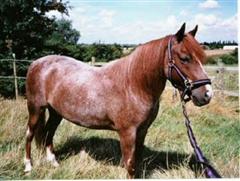Banker
N/A
Sat, 19th July, 2025 - 3:30 am GMT
Sponsor Ads:

Alternative Name
N/ABasic Info
These horses stand between 13 and 14.3 hands high and are found predominantly in brown, bay, dun, and chestnut.
Health
N/AHabitat
N/ABehavior
The Banker Pony also referred to as the Shackleford Horses stand about 14 hh and originated on the Outer Bank Islands of North Carolina. The ancestors of these ponies were Spanish horses that came from Spain through Hispaniola in the 16th century. These wild ponies were said to have swam to these islands from shipwrecked ships long before the English colonized this area. The Banker Ponies would eat the coarse salt grass of the marshes and dig holes in the sand for fresh water for survival and flourished. During the late 1800s many of these wild ponies that were in certain areas were willed to the younger generation. In 1957 a plea was made to the government to let these wild ponies stay on these islands. By 1980 public interest in the ponies welfare became significant. Members of the Spanish Mustang Registry came to visit these ponies and found by genetic testing that many of these ponies were pure enough to qualify to be on the Spanish Mustang Registry. A few of the Banker Ponies have been registered on the Spanish Mustang Registry over the years. The protection act for the Banker Ponies was made public law in 1998 this act was called the “Shackleford Banks Wild Horses Protection Act” which would protect the Banker Ponies of the Outer Bank Islands of Hatteras, Shackleford, and Ocracoke. The Banker Ponies numbers are in the hundreds today and they are protected.Origin
North CarolinaHistory
The Banker is a feral horse that has existed for centuries on the islands of North Carolina's Outer Banks. The area is known for its lack of vegetation and water. The horse population survives on the marsh grass and by scratching through the sand for water seepage. Today there are very few Bankers left due to environmental problems and management agencies. The Banker carries many of the same characteristics as the influential Spanish mustang-type. Unlike most wild horses, however, it is generally friendly and calm.No one is certain of the exact origin of the Banker Horse, but there is no doubt that it is of Spanish stock. The region was first colonized by Spanish explorers in the 1520s, and later again in the 1580s by the English. Both were known to have brought stock over. Whether these animals escaped, were released, or saved from shipwreck is uncertain. Whatever the case, by the 1700s horses were well documented on the Outer Banks. Because of the relatively isolated environment, the horses remain a relatively pure stock. Many of the horses that still do exist are alive thanks to the efforts of Dale Burrus, a Banker Horse enthusiast. Not only has he collected and preserved the horse, he has also sought to keep the wild population in their natural state on the islands. Differences between naturalists and horse enthusiasts are still present, leaving the future of the horse uncertain.Common Foods
grassSponsor Ads:
Only presidents, editors, and people with tapeworms have the right to use the editorial "we."
Banker
Coded by: BGID® | ALL RIGHTS RESERVED Copyright © 2000-2025
Disclaimer | Privacy | Report Errors / Contact | Credits


 Why haven't we as a collective earth met with aliens yet?
Why haven't we as a collective earth met with aliens yet?  World EcoSystem - Biodiversity Changes - Who is on board and who isn
World EcoSystem - Biodiversity Changes - Who is on board and who isn  Homosexual behavior stems from the mind or genetics?
Homosexual behavior stems from the mind or genetics?  The Best Text Adventure You Will Ever Play! The official site:
The Best Text Adventure You Will Ever Play! The official site:  Mouthwash - Mouthrinse - Mouth Sores - Healing Infections - Gingivitis
Mouthwash - Mouthrinse - Mouth Sores - Healing Infections - Gingivitis  Treatment for Depression
Treatment for Depression  Ultra radical and violent Islamist group that even rivals Al Qaeda
Ultra radical and violent Islamist group that even rivals Al Qaeda  An idea to have teachers who want to carry guns to school undergo some level of police training will be left up to local school districts and police departments.
An idea to have teachers who want to carry guns to school undergo some level of police training will be left up to local school districts and police departments.